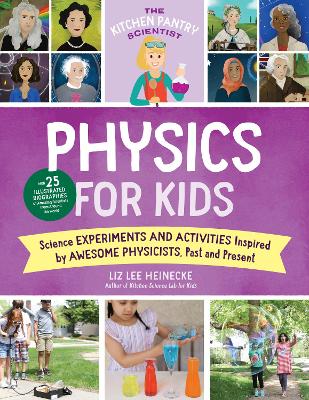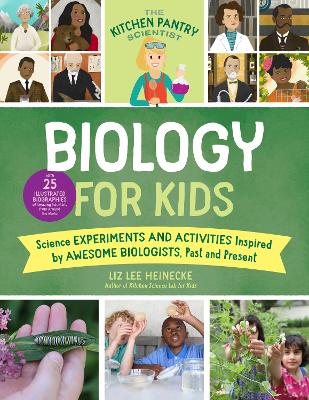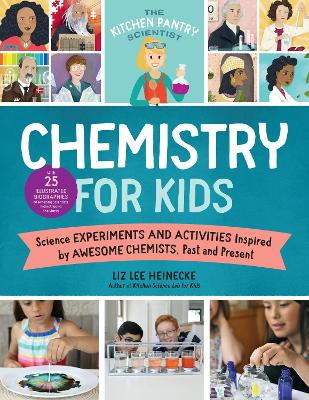The Kitchen Pantry Scientist
1 primary work • 5 total works
Book 3
Make a water rocket and engineer the perfect paper airplane. Play with mirror images. Use atmospheric pressure to push an egg into a bottle. Crush a mint to create a flash of light.
This engaging guide offers a series of snapshots of 25 scientists famous for their work with physics, from ancient history through today. Each lab tells the illustrated story of a scientist along with some background about the importance of their work, and a description of where it is still being used or reflected in today’s world.
A step-by-step experiment paired with each story offers kids a hands-on opportunity for exploring concepts the scientists pursued, or are working on today. Experiments range from very simple projects using materials you probably already have on hand, to more complicated ones that may require a few inexpensive items you can purchase online. Just a few of the incredible people and scientific concepts you'll explore:
Galileo (b. 1564)
Play with pendulums
Sir Isaac Newton (b. 1642)
Center of gravity balancing trick
Albert Einstein (b. 1879)
Playground ball relativity
Stephen Hawking (b. 1942)
Collapsing stars and black holes
Christine Darden (b. 1942)
Engineer a perfect paper airplane
With this fascinating, hands-on exploration of the history of physics, inspire the next generation of great scientists.
Dig into even more incredible science history from The Kitchen Pantry Scientist series with: Chemistry for Kids, Biology for Kids, Math for Kids, and Ecology for Kids.
Play disease detective to learn how John Snow tracked down the source of a cholera epidemic. Learn about biologist Ernest Everett Just’s discoveries and experiment with osmosis using eggs with dissolved shells. Make your own agar plates for growing bacteria and fungi just like Fannie Hess.
This engaging guide offers a series of snapshots of 25 scientists famous for their work with biology, from ancient history through today. Each lab tells the story of a scientist along with some background about the importance of their work, and a description of where it is still being used or reflected in today’s world.
A step-by-step illustrated experiment paired with each story offers kids a hands-on opportunity for exploring concepts the scientists pursued, or are working on today. Experiments range from very simple projects using materials you probably already have on hand, to more complicated ones that may require a few inexpensive items you can purchase online. Just a few of the incredible people and scientific concepts you’ll explore:
Maria Sibylla Merian (b. 1647)
Observe, photograph and illustrate insects on plants
Scientific concepts: observation and documentation of insect habitat and metamorphosis
Charles Darwin (b. 1809)
Play a competitive advantage game.
Scientific concepts: natural selection and evolution
Louis Pasteur (b. 1822)
Make a flask like Pasteur’s to grow microbes from the air.
Scientific concepts: microbial fermentation and germ theory
Rae Wynn-Grant (b. 1985)
Use cookie crumbs to attract ants. Observe the behavior of ants and other animals.
Scientific concepts: ecology and animal behavior
Biology is the name for the study of living organisms, but long before the word biologist was coined, people around the world realized that by studying the world around them, they could improve their lives. Learning about plants and insects helped them discover new medicines and grow better crops. Studying animals taught them how to raise healthy poultry, cattle, and horses for food, farming, and transportation.
Today’s biologists study everything imaginable. From oceans, jungles, and cities to the space station, the universe is their laboratory. Like those who went before them, they are fascinated by plants, animals, and microbes and understand that their discoveries can make the world a better place for all living things.
With this fascinating, hands-on exploration of the history of biology, inspire the next generation of great scientists.
Dig into even more incredible science history from The Kitchen Pantry Scientist series with: Chemistry for Kids, Physics for Kids, Math for Kids, and Ecology for Kids.
* 2021 NSTA-CBC Outstanding Science Trade Book
* 2021 EUREKA! Nonfiction Children’s Honor Book
Aspiring young chemists will discover an amazing group of role models and memorable experiments in Chemistry for Kids, the debut book of The Kitchen Pantry Scientist series.
Replicate a chemical reaction similar to one Marie Curie used to purify radioactive elements. Distill perfume using a method created in ancient Mesopotamia by a woman named Tapputi.
This engaging guide offers a series of snapshots of 25 scientists famous for their work with chemistry, from ancient history through today. Each lab tells the story of a scientist along with some background about the importance of their work, and a description of where it is still being used or reflected in today’s world.
A step-by-step illustrated experiment paired with each story offers kids a hands-on opportunity for exploring concepts the scientists pursued, or are working on today. Experiments range from very simple projects using materials you probably already have on hand, to more complicated ones that may require a few inexpensive items you can purchase online. Just a few of the incredible people and scientific concepts you’ll explore:
Galen (b. 129 AD)
Make soap from soap base, oil, and citrus peels.
Modern application: medical disinfectants
Joseph Priestly (b. 1733)
Carbonate a beverage using CO2 from yeast or baking soda and vinegar mixture.
Modern application: soda fountains
Alessandra Volta (b. 1745)
Make a battery using a series of lemons and use it to light an LED.
Modern application: car battery
Tu Youyou (b. 1930)
Extract compounds from plants.
Modern application: pharmaceuticals and cosmetics
People have been tinkering with chemistry for thousands of years. Whether out of curiosity or by necessity, Homo sapiens have long loved to play with fire: mixing and boiling concoctions to see what interesting, beautiful, and useful amalgamations they could create. Early humans ground pigments to create durable paint for cave walls, and over the next 70 thousand years or so as civilizations took hold around the globe, people learned to make better medicines and discovered how to extract, mix, and smelt metals for cooking vessels, weapons, and jewelry. Early chemists distilled perfume, made soap, and perfected natural inks and dyes.
Modern chemistry was born around 250 years ago, when measurement, mathematics, and the scientific method were officially applied to experimentation. In 1896, after the first draft of the periodic table was published, scientists rushed to fill in the blanks. The elemental discoveries that followed gave scientists the tools to visualize the building blocks of matter for the first time in history, and they proceeded to deconstruct the atom. Since then, discovery has accelerated at an unprecedented rate. At times, modern chemistry and its creations have caused heartbreaking, unthinkable harm, but more often than not, it makes our lives better.
With this fascinating, hands-on exploration of the history of chemistry, inspire the next generation of great scientists.
Dig into even more incredible science history from The Kitchen Pantry Scientist series with: Biology for Kids, Physics for Kids, Math for Kids, and Ecology for Kids.
Aspiring young ecologists will discover an amazing group of role models and memorable experiments in Ecology for Kids, the fifth book in The Kitchen Pantry Scientist series.
*2024 AAAS/Subaru SB&F Prize for Excellence in Science Books in the Hands-On Science Book Shortlist*
*2024 Minnesota Book Awards Finalist, Middle Grade Literature*
This engaging guide offers a series of snapshots of 25 scientists famous for their work with ecology. Each lab tells the story of a scientist along with some background about the importance of their work, and a description of where it is still being used or reflected in today’s world.
A step-by-step illustrated experiment paired with each story offers kids a hands-on opportunity for exploring concepts the scientists pursued, or are working on today. Experiments range from very simple projects using materials you probably already have on hand, to more complicated ones that may require a few inexpensive items you can purchase online. Just a few of the incredible people and scientific concepts you’ll explore:
Eunice Newton Foote (b. 1819)
See how carbon dioxides trap heat
George Washington Carver (b. 1864)
Grow beans and study soil conditions
Rachel Carson (b. 1907)
Test the water clarity from local ponds, lakes, or steams
E. O. Wilson (b. 1929)
Observe insects in their natural habitats
With this fascinating, hands-on exploration of the history of ecology, inspire the next generation of great scientists.
Dig into even more incredible science history from The Kitchen Pantry Scientist series with: Chemistry for Kids, Biology for Kids, Physics for Kids, and Math for Kids.
Women have been involved in STEM (Science, Technology, Engineering, and Math) for thousands of years. While many have faced obstacles because of their gender, things are changing for the better, and today there are more women than ever working in these disciplines.
By examining the moments that inspired successful women to pursue STEM fields, delving into their adventures and struggles, and exploring their interests outside of science and engineering, She Can STEM gives kids a rare glimpse into the fascinating personalities behind the lab coats.
Just a few of the many curious, creative, and persevering women introduced:
- Physicist Dr. Nadya Mason – Dr. Mason studies how electrons move through materials like carbon and graphene. She ran track in high school and was a gymnast on the United States National Team.
- Ecologist Dr. Robin Wall Kimmerer – When she was a young girl, Dr. Kimmerer loved to pick wild strawberries and nature helped her reconnect with her Potawatomi heritage. Eventually, her love of the outdoors led to a successful career as a plant ecologist and author.
- Physicist Dr. Chanda Prescod-Weinstein – As a kid, Dr. Prescod-Weinstein dreamed of becoming a professional baseball player. She attended a performing arts school where she trained as a dancer before going on to study astronomy and theoretical physics.
- Chemist Dr. Raychelle Burks – Dr. Burks has loved Agatha Christie mysteries and Star Trek since she was young. Today, she works to create hand-held sensing systems that can identify chemical clues tied to crimes.
- Microbiologist Dr. Esther Lederberg – Dr. Lederberg was a child during the Great Depression and was often hungry. Although she enjoyed literature, music, and French, she eventually chose biochemistry as her field of study and went on to make many important discoveries.
Whether you’re passionate about science, math, history, art, music, or sports, the relatable role models in She Can STEM demonstrate that with curiosity and hard work, anyone can pursue a bright future in STEM.
Dig into even more incredible science history from The Kitchen Pantry Scientist series with: Physics for Kids, Chemistry for Kids, Biology for Kids, Math for Kids, and Ecology for Kids.




